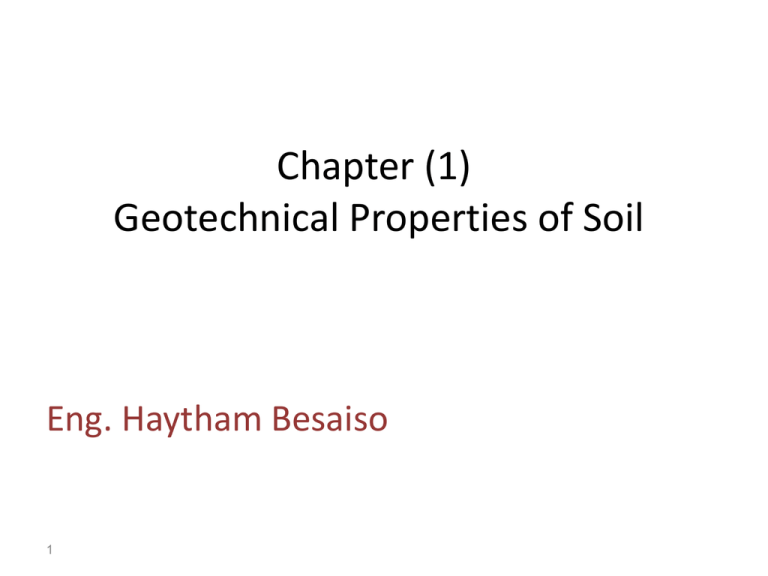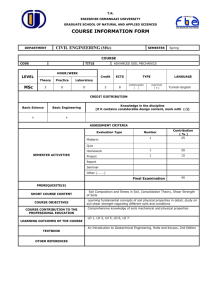Ch1
advertisement

Chapter (1) Geotechnical Properties of Soil Eng. Haytham Besaiso 1 EFFECTIVE STRESS Stress and pressure are often used interchangeably in geotechnical engineering. Effective Stress Equation: Many engineering analyses use the vertical effective stress, also known as the effective overburden stress. Total ' u 2 Pore Water Pressure: • For dry sand, the pore water pressure is zero. This is because there is no water in the soil pores and hence there is no water pressure. • In this case with the pore water pressure u is equal to zero, the total stress is equal to the effective stress. 3 - The usual case is that there will be water in the void spaces between the soil particles. - For the condition of a soil below a groundwater table and for hydrostatic water pressure (i.e., no groundwater flow or excess pore water pressures), the pore water pressure is: u where 4 w zw u :pore water pressure (psf or kPa) w :unit weight of water (62.4 pcf or 9.81 kN m3) zw :depth below the groundwater table (ft or m) For cases where there is flowing groundwater or excess pore water pressure due to the consolidation of clay, the pore water will not be hydrostatic. Engineering analyses, such as seepage analyses or the theory of consolidation can be used to predict the pore water pressure. For some projects, piezometers can be installed to measure the pore water pressure u in the ground. 5 Example Total 1 h1 2 h2 u w h2 . ' Total u 1 h1 2 h2 w h2 1 h1 ( 2 w )h2 1 h1 ' h2 6 Settlement In general, the total settlement S of a foundation can be given as: S = Se+ Sc +Ss Where: Se = elastic settlement Sc = primary consolidation settlement Ss = secondary consolidation settlement 7 Immediate settlement: The settlement that occurs immediately after applying the loads on the soil. 1 2 Se B I p. Es Se : im m ediatesettlement. : Appliedpressure. B : Width of thefoundationor diameterif it was circular. : Poisson' s ratio (0 0.5) Es : Soil Modulusof elasticity. I p : Factorgiven from tablesdepend on typeof foundation(flexibleor rigid) and also theshape (circular or rectangular). 8 Consolidation settlement Consolidation: According to Terzaghi (1943), “a decrease of water content of a saturated soil without replacement of the water by air is called a process of consolidation.” According to consolidation, soil can be classified to three types: 1. Normally consolidated 2. Overconsolidated 3. Underconsolidated 9 Normally consolidated: A soil is called normally consolidated if the present effective overburden pressure is the maximum to which the soil has ever been subjected . Overconsolidated (preconsolidated ): A soil is called overconsolidated if the present effective overburden pressure is less than the maximum to which the soil was ever subjected in the past.. Underconsolidated: A soil is called overconsolidated if the present effective overburden pressure is more than the maximum to which the soil was ever subjected in the past. 10 * The overconsolidation ratio (OCR) is defined as the ratio of the past effective pressure c to the present overburden ' ' pressure o , OCR = c/ o - A normally consolidated soil has OCR = 1 and an overconsolidated soil has OCR > 1. - OCR values of 1-3 are obtained for lightly overconsolidated soils. - Heavily overconsolidated soils might have OCRs > 6 to 8. - An underconsolidated soil will have OCR < 1. In this case the soil is still consolidating 11 Total primary consolidation settlement :* For normally consolidated soil: Cc H o' ' log S C ' 1 eo o Cc : Compressio n index 0.009(LL - 10) H : Thickness of layer under considrati on. eo : Initial void ratio. o' : Over burned pressure (effective stress). ' : Added vertical pressure. * For overconsolidated clay with o' <= c ' ' CsH log o SC ' 1 eo o 12 ' * For overconsolidated clay with 0 '< c < o CsH c log ' SC 1 eo o 13 CsH o' ' log ' 1 eo o Shear strength • Soil strength is the resistance to mass deformation developed from a combination of particle rolling, sliding, and crushing and is reduced by any pore pressure that exists or develops during particle movement. • This resistance to deformation is the shear strength of the soil as opposed to the compressive or tensile strength of other engineering materials. • The shear strength is measured in terms of two soil parameters: cohesion "c" and angle of internal friction "φ“ • The strength parameters are often used as constants, but they are quite dependent on the type of laboratory test, previous stress history, and current state (particle packing, 14grain shape, and water content). • As a consequence, obtaining accurate values is not a trivial task, and the values obtained actually apply only to the current soil state. The general equation to calculate the shear strength at failure is coulomb equation: f c tan f : Shear strength at failure. c : cohesion : vertical stress : Angle of internal friction 15 By determining the values of & at plane (ab), if it lies at point A, it means that no shear failure will occur at plane (ab), but if it lies at point B it means that it will fail at plane (ab), Point C can’t be achieved because the soil will be failed before it. 16 There are many laboratory tests to obtain these parameters, the famous tests are: • Direct shear test: 17 • Triaxial shear test: By changing 3 several times we can obtain more than Mohr circle, the common tangent for these circles is the shear failure envelope, by which we can find the shear strength parameters 18 SHEAR STRENGTH OF COHESIONLESS SOIL: The shear strength testing should be performed on saturated soil specimens. This is because the shear strength testing of partially saturated soil could overestimate the shear strength if the soil should become wetter. Cohesionless soils can also be tested in a dry state and the shear strength of the soil is then expressed in terms of the friction angle . In a comparison of the effective friction angle ' from drained direct shear tests on saturated cohesionless soil and the friction angle f from direct shear tests on the same soil in a dry state, it has been determined that ' is only 1%to 2%lower than . slight difference is usually ignored and the friction angle and effective friction angle ' are typically considered to mean the same thing for cohesionless soils. 19 In summary, for the shear strength of cohesionless soils, c' =0 and the effective friction angle ' depends on: • Soil type : Sand and gravel mixtures have a higher effective friction angle than nonplastic silts • Soil density: For a given cohesionless soil, the denser the soil, the higher the effective friction angle. This is due to the interlocking of soil particles. It has been observed that in the ultimate shear strength state, that the shear strength and density of a loose and dense sand tend to approach each other. 20 • Grain size distribution: A well graded cohesionless soil will usually have a higher friction angle than a uniform soil. With more soil particles to fill in the small spaces between soil particles, there is more interlocking and frictional resistance developed for a well graded than for a uniform cohesionless soil. • Mineral type, angularity, and particle size: Soil particles composed of quartz tend to have a higher friction angle than soil particles composed of weak carbonate. Angular soil particles tend to have rougher surfaces and better interlocking ability. Larger size particles, such as gravel size particles, typically have higher friction angles than sand. 21 • Deposit variability: Because of variations in soil types, gradations, particle arrangements, and dry density values, the effective friction angle is rarely uniform with depth. It takes considerable judgment and experience in selecting an effective friction angle. * SHEAR STRENGTH OF COHESIVE SOIL * In general the shear strength of cohesive soils tend to be lower than the shear strength of cohesionless soils. As a result, more shear induced failures occur in cohesive soils, such as clays, than in cohesionless soils. 22 Distinguish between: Soil compaction and consolidation Distinguish between: Relative compaction and relative density 23 Relative Density Equation emax emeasured Rd (%) x100 emax emin Diagram below illustrates a relative density of about 40 % emin dmax emeasured d measured increasing density 24 emax d min Relative density is sometimes used to describe the state condition in cohesionless soils. Relative density is defined in terms of natural, maximum, and minimum void ratios e 25 Relative compaction or percent compaction R.C. d filed d max laboratory 100% Correlation between relative compaction (R.C.) and the relative density Dr R.C. 80 0.2Dr 26 COMPACTION • Man made • Volume reduction due to expulsion of air • Sudden (Short duration) • Dry density increases water content does not change • Applicable for unsaturated soils CONSOLIDATION • Natural • Volume reduction due to expulsion of water • Gradual • Dry density increases water content decreases • Applicable for saturated soils 27 28 The process of consolidation is often confused with the process of compaction. Compaction increases the density of an unsaturated soil by reducing the volume of air in the voids . Objectives: • Decrease future settlements • Increase shear strength • Decrease permeability 29 However, consolidation is a time-related process of increasing the density of a saturated soil by draining some of the water out of the voids . Consolidation is generally related to finegrained soils such as silts and clays. Coarsegrained soils, such as sands and gravels, also undergo consolidation but at a much faster rate due to their high permeability. Saturated clays consolidate at a much slower rate due to their low permeability. 30 All The Best 31







